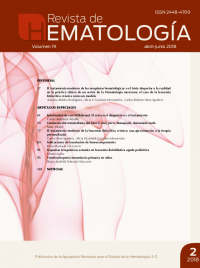Indications of blood components transfusion.
Rev Hematol Mex. 2018 abril-junio;19(2):83-90.
Erika Maricela Gil-García
* Presentado en el LIX Congreso Nacional de Hematología, 25-29 de abril de 2018. Nuevo Vallarta, México.
Banco de Sangre, UMAE, Centro Médico Nacional Siglo XXI, Ciudad de México, México.
Resumen
La medicina transfusional es una disciplina que interactúa con todas las especialidades, con mayor prescripción en el paciente onco-hematológico como tratamiento coadyuvante o paliativo y es piedra angular en el choque hemorrágico. La recomendación al prescribir hemocomponentes es individualizar la terapia con base en el estado clínico del paciente, causa del déficit del componente sanguíneo y considerar alternativas a la transfusión. Se describen las recomendaciones, indicaciones y consideraciones especiales en los distintos procedimientos transfusionales. En la transfusión masiva, el éxito conlleva evitar la aparición de la coagulopatía asociada. El objetivo de la transfusión de concentrados eritrocitarios es garantizar la perfusión celular, considerar alternativas como transfusión de sangre autóloga, hierro y eritropoyetina. Las indicaciones de la transfusión plaquetaria se basan en las guías ASCO 2018 y AABB. El uso del plasma fresco congelado se basa en el análisis de la biometría hemática, tiempo de hemorragia y tiempos de coagulación. Los crioprecipitados están indicados en protocolo de transfusión masiva, disfirinogenemia, enfermedad de von Willebrand y deficiencia del factor FXIII. El objetivo de los productos irradiados es la prevención de enfermedad injerto contra huésped. En conclusión, antes de prescribir una transfusión es importante establecer el riesgo-beneficio, individualizar la terapia en el contexto clínico, identificar la causa y establecer el objetivo terapéutico, así como cumplir con la normativa y contar con los documentos pertinentes en el expediente clínico del paciente.
PALABRAS CLAVE: Hemocomponentes; transfusión plaquetaria.
Abstract
Transfusion medicine is a discipline that interacts with all specialties, with a greater prescription in the onco-hematological patient as a coadjutant or palliative treatment and is a cornerstone in hemorrhagic shock. The recommendation in prescribing blood components is to individualize the therapy based on the patient’s clinical status, the etiology of the blood component deficit and consider alternatives. The recommendations, indications and special considerations are described in the different transfusion procedures. Massive transfusion, the success in resuscitation is to avoid the development of coagulopathy associated with trauma. Transfusion erythrocyte concentrates, the objective is to guarantee cellular perfusion, and consider alternatives such as transfusion of autologous blood, iron and erythropoietin. Platelet transfusion, indications are based on the ASCO 2018 and AABB guidelines. Fresh frozen plasma, its use is based on the analysis of blood count, bleeding time and coagulation times. Cryoprecipitates, indicated in the massive transfusion protocol, Von Willebrand disease and deficiency of the FXIII factor. Irradiated products, the objective are the prevention of graft-versus-host disease. In conclusion, it is important before prescribing a transfusion to establish the risk-benefit, to individualize the therapy in the clinical context, to identify etiology and to establish the therapeutic objective. Comply with the regulations and have the relevant documents in the patient’s clinical file.
KEYWORDS: Blood components; Platelet transfusion.

